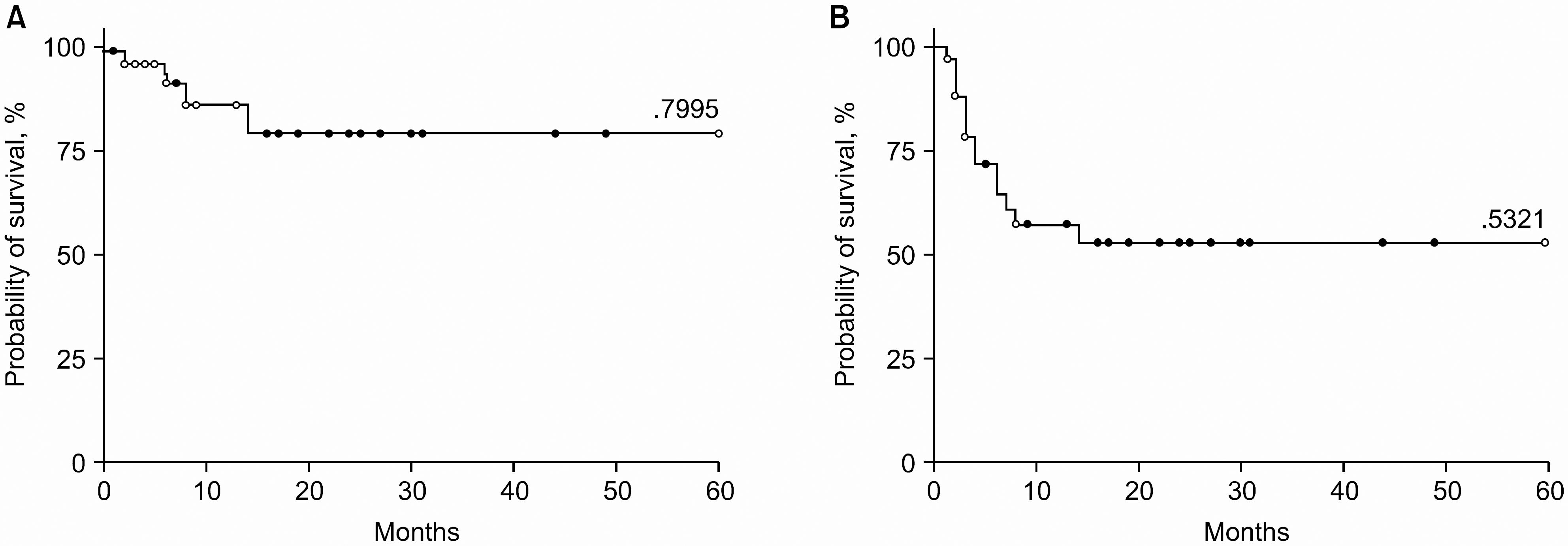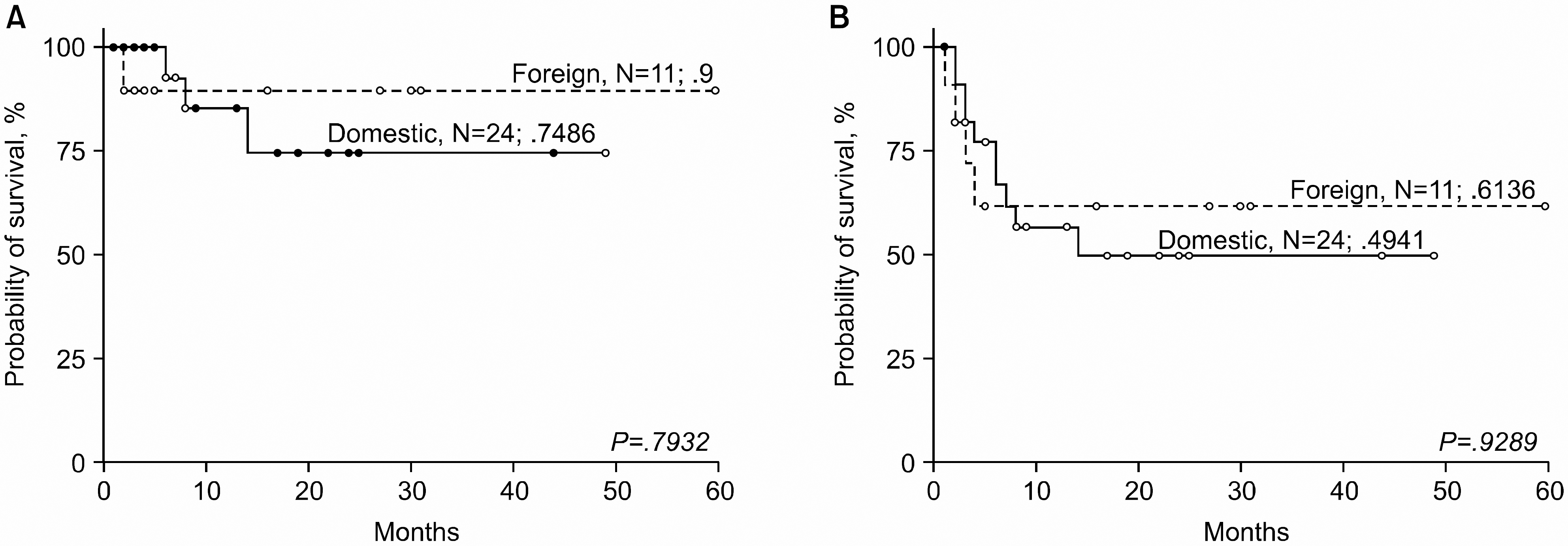Abstract
Background:
Many AML patients have received hematopoietic stem cell transplantation (HSCT) from HLA-matched unrelated donors. According to many of the previous reports, those patients could achieve long-term, disease-free survival after HSCT from multinational unrelated donors with tolerable transplant-related complications, even when there are HLA-mismatches.
Methods:
We present the results of 35 unrelated hematopoietic stem cell transplantations from multiple international donor banks including the Korean (n=24), and Japan Marrow Donor Program (n=3), the Taiwan Tzu Chi Marrow Donation Registry (n=6), as well as using Caucasian donors from the National Marrow Donor Program (n=2), for the treatment of AML patients.
Results:
The median age of patients was 36 (range: 16∼53) and the median follow-up duration was 21 months (range: 5∼60). Also, the median age of the donors was 28 (range: 20∼53). The majority of the patients had intermediate or unfavorable cytogenetic features. The main conditioning regimen we used consisted of cyclophosphamide plus TBI (n=31) with our standard GvHD prophylaxis that contained tacrolimus plus a short course of methotrexate. Some patients (n=10) received an additional two-day course of ATG (thymoglobulin, Sangstat) in addition to the standard regimen. All the transplanted patients achieved engraftment. The incidence of acute GvHD was 42%, and that of chronic GvHD was 56%. Four (11%) patients have relapsed to date. The two-year non-relapse transplant-related mortality was 26%. The estimated probability of DFS and the event-free survival at five-years were 80% and 53%, respectively.
Go to : 
REFERENCES
1). Anasetti C., Petersdorf EW., Martin PJ., Woolfrey A., Hansen JA. Improving availability and safety of unrelated donor transplants. Curr Opin Oncol. 2000. 12:121–6.

2). Gratwohl A., Baldomero H., Frauendorfer K, et al. Results of the EBMT activity survey 2005 on haematopoietic stem cell transplantation: focus on increasing use of unrelated donors. Bone Marrow Transplant. 2007. 39:71–87.

3). Kodera Y., Morishma Y., Kato S, et al. Analysis of 500 bone marrow transplants from unrelated donors (UR-BMT) facilitated by the Japan Marrow Donor Program: Confirmation of UR-BMT as a standard therapy for patients with leukemia and aplastic anemia. Bone Marrow Transplant. 1999. 24:995–1003.

4). Sierra J., Storer B., Hansen JA, et al. Transplantation of marrow cells from unrelated donors for treatment of high-risk acute leukemia: the effect of leukemic burden, donor HLA-matching, marrow cell dose. Blood. 1997. 89:4226–35.
5). Sierra J., Storer B., Hansen JA, et al. Unrelated donor marrow transplantation for acute myeloid leukemia: an update of the Seattle experience. Bone Marrow Transplant. 2000. 26:397–404.

6). Davies SM., Kollman C., Anasetti C, et al. Engraftment and survival after unrelated donor bone marrow transplantation: a report from the national marrow donor program. Blood. 2000. 96:4096–102.
7). Petersdorf EW., Malkki M. Human leukocyte antigen matching in unrelated donor hematopoietic cell transplantation. Semin Hematol. 2005. 42:76–84.

8). Speiser DE., Tiercy JM., Rufer N, et al. High resolution HLA matching associated with decreased mortality after unrelated bone marrow transplantation. Blood. 1996. 87:4455–62.

9). Petersdorf EW., Gooley TA., Anasetti C, et al. Opti-mazing outcome after unrelated marrow transplantation by comprehensive matching of HLA class I and II alleles in the donor and recipient. Blood. 1998. 92:3515–20.
10). Slovak ML., Kopecky KJ., Cassileth PA, et al. Karyotypic analysis predicts outcome of preremission and postremission therapy in adult acute myeloid leukemia: a Southwest Oncology Group/Eastern Cooperative Oncology Group study. Blood. 2000. 96:4075–83.

11). Park HS., Kim DW., Kim CC, et al. Induction chemotherapy with Idarubicin plus N4-behenoyl-1-b-D-ara-binofuranosylcytosine in acute myelogenous leukemia: a newly designed induction regimen - a prospective, cooperative multicenter study. Semin He-matol. 1996. 33(Suppl.3):24–9.
12). Miller AB., Hoogstraten B., Staquet M., Winkler A. Reporting results of cancer treatment. Cancer. 1981. 47:207–14.

13). Bacigalupo A., Lamparelli T., Bruzzi P, et al. Antithymocyte globulin for graft-versus-host disease prophylaxis in transplants from unrelated donors: 2 randomized studies from Gruppo Italiano Trapianti Mi-dollo Osseo (GITMO). Blood. 2001. 98:2942–7.

14). Basara N., Baurmann H., Kolbe K, et al. Antithymocyte globulin for the prevention of graft-versus-host disease after unrelated hematopoietic stem cell transplantation for acute myeloid leukemia: results from the multicenter German cooperative study group. Bone Marrow Transplant. 2005. 35:1011–8.

Go to : 
 | Fig. 1Disease-free survival rate (A) and event-free survival rate (B) of mismatched unrelated donor HSCT from multinational donor registries worldwide. |
 | Fig. 2Defined outcomes according to the different donor registries included. Disease-free survival rate (A) and event-free survival rate (B) of mismatched unrelated donor HSCT from multinational donor registries. |
Table 1.
Characteristics of donors (D) and AML recipients (R) in this study




 PDF
PDF ePub
ePub Citation
Citation Print
Print


 XML Download
XML Download